Foraging Perspectives: Foraging in 1950’s Russia
I was delighted to receive a comment on one of my website posts, reminiscing at length about foraging and rural life in post-war Soviet Union . The author was Eslanda Goode Ramos, and I found her recollections and descriptions so interesting that I asked her if she would mind expanding on them for inclusion in a blog post. Eslanda kindly agreed and I hope you find her story and experiences as fascinating as I do…
Note: These are all Eslanda’s words, with some minimal editing and structuring from me for clarity, but hopefully not altering her distinctive voice. I particularly love Eslanda’s eye for detail and long sentences (which she explains below, are very Russian!) I have added a few links and photos (which Eslanda agrees are helpful/accurate) to add further depth.
“I’ve had an out of the ordinary life being a child of an American romantic, who loved to travel the world, and got trapped in the Soviet Union in the horrible time of Stalin purges. Having signed a job contract, he didnt imagine it would be a life sentence. Stripped of his American documents under a false explanation, like for issuing a work visa, he never saw them again. He couldnt appeal to the US embassy – he was African American, and, as the US Embassador said to me in 1990, the then racist embassy wouldn’t help the Negro, who dared to work and be successful in communist Russia.
.

Eslanda age 8 or 9
.
“Worse even, he could be extradited, or brought back just to be prosecuted for anti-American activity, like his brother-in-law, great American fighter for human rights
Paul Robeson. He chose to live in hiding, avoiding foreign journalists, kept working, and live life among ordinary Russians, married a Russian, had me, his only daughter.
.

Paul Robeson
.
“He was a widely educated man. Born in 1894, a grandson of Francis L.Cardozo, the first Black secretary of state in South Carolina, and a great educator (he founded Avory Institute in Charteston, and later, working in Washington DC, founded the first integrated high school there, now Cardozo High School). My father studied in Columbia for 2 years, couldnt continue, but was a great reader and researcher of life, was a living encyclopedia of knowledge.
.
“He lived to the age of 73, was loved and respected by all ordinary Russians, and took care of protecting me from the controversy of his situation and possible confusion. At home, with him I was an American child, and he did all to raise me in love and learning all things American, good and bad, but mostly good, history, songs, literature.
.

Nizhni Novgorod today
.
“But outside our small 2-room cold apartment in Nizhni Novgorod, my mother’s native city, restricted for foreigners’ visits – my father’s choice away from journalists – I grew up as a Russian child, with the capacity to see things a little better, to learn about everything to the core, more knowlegeable and aware to view things from not only one perspective.
.
.
“I’m now a retired linguist, a specialist in teaching second language acquisition, both Russian and English. 30 years in the US. This combination – the language and speech specialty and free time – results in such long detailed narratives as this! Get used to my long sentences, after all I had been speaking and reading mostly Russian, in its substantial spread and precise descriptions. Feel free to modify to fit the average American attention span. Remembering, that the novels of the great Leo Tolstoy, thick when printed in Russian, look much thinner in English translation. His sentences suffer from adaptation, to keep the American reader’s limited attention. English itself is less “bulky” than Russian, with shorter words and structures.
.
“My mother, took me from Nizhni Novgorod to a remote village, having befriended a milk-lady who used to bring (on her back) a huge aluminum jug of milk to our apartment building and her usual patrons. My mother learned, that the milk-lady’s mother lived in a remote village called Yelkhovka (7 km from the railway, with the train stopping for 2 minutes) with no electricity, paved roads or transportation. With a small store with bread, salt/sugar and some canned food, some basic garden tools, fabrics, soap – nothing else, really, one tiny room at the simple station. People in that village lived a simple life, with their cows, goats, pigs, geese and chickens.
.
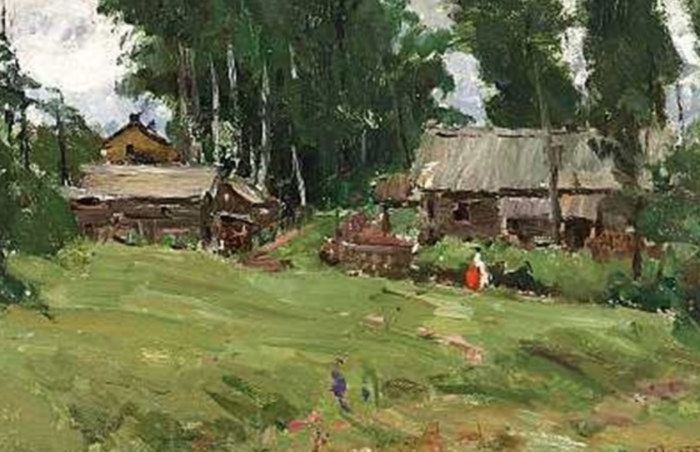
Scene from a North-Western Russian village on the edge of the forest (unattributed artist) , 1935
.
“My parents couldn’t consider any holiday resorts, couldn’t afford anything fancier, but they believed fresh air, natural organic food, and opportunity for me to see real life, be closer to nature, learn and be active physically was precious. And I am so grateful for their decision.
.
“So, at my 7 years of age, from a huge polluted noisy city my mom and I rode an “electritchka” – electric train, and walked аll the way to that village. Living there in a tiny room of Baba Nadya’s “izbA” (capitalizing a stressed vowel), a substantial simple Russian log house, with dimple carved wooden ornament around small windows. The village consisted of 14 of these.
.
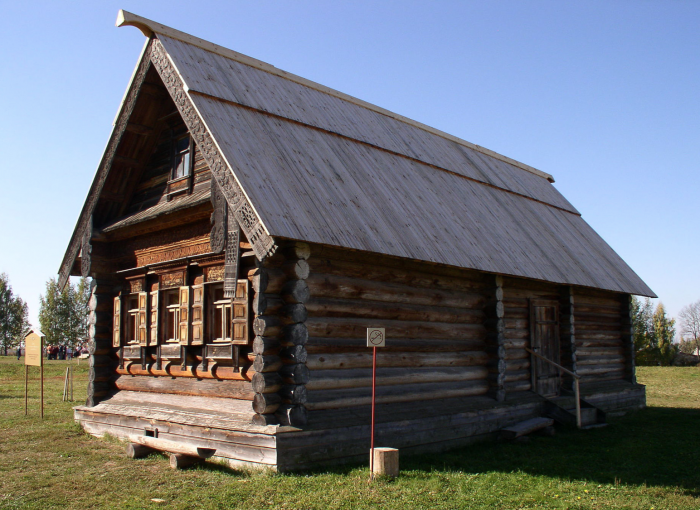
A typical izbA
.
“Baba Nadya (“baba” is the simple, affectionate abbreviation for “babushka”, meaning “grandma”), had a goat and chickens. Goat milk, fresh eggs and vegetables (radishes, turnips, scallions, onions, carrots, potatoes we pulled out as we needed them), some butter the neighbour with a cow sold to us, sunflower oil from the shop at the station, and unbelievably tasty porous heavy bread baked by Baba Nadya – that was our food, simple, healthy.
.
“Sugar was in tight big lumps, to be sawed and then chipped with special chippers. I learned to drink tea with a chip of sugar behind my cheek, it didnt fall apart like regular sugar pieces from boxes. And it was more delicious. My mom until her death in 2005 had her tea with sugar or hard candy in her mouth to last through the whole cup.
.
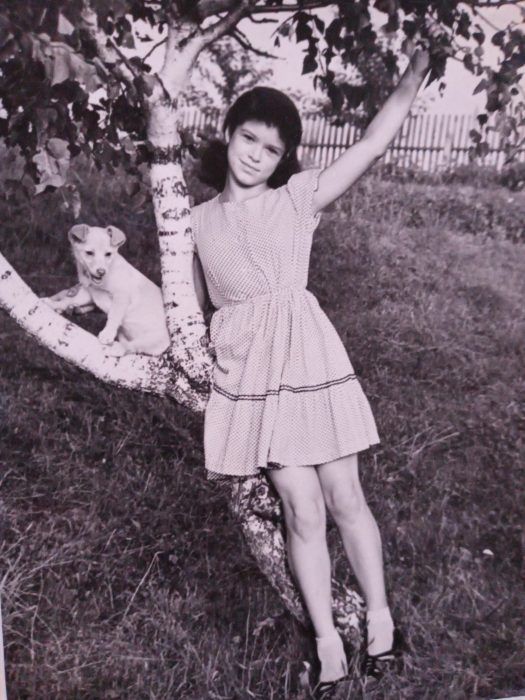
Eslanda age 13(?)
.
“Villagers didnt bother to grow fruit or berries. Occasional apple trees or old black cherry trees (regular cherries cant grow in mid and northern Russia) could be seen here and there. By law, people could have only small patches of land next to their houses, to use as a yard and or veggie garden. People often grew potatoes in the yard, or faraway where controllers wont find and fine for illegal use of the state land.
.
“At that time (the 50s) it was still a hard hard life in the country, with 20+ million people, almost all of them men – perished in the WW2, with many who survived being crippled physically and/or mentally. Alcoholism was very common, a result of a Russian tradition to celebrate or mourn with vodka or other strong, often dangerous homemade “bragah”. They had spent 5 years at war, boosting up their courage before the battles with 100 gram of vodka ration – and more, if the battle was won, to celebrate.
.

Home distilling braga
.
“My village population consisted almost entirely of sober war widows – they simply didn’t have money to buy vodka, didnt have men-alcoholics. So I was spared from seeing drunk men, fights, other ugly scenes I often saw in the city. The war widows lived their lives tending to their few cows, or just a goat for milk and butter, and vegetable and potato patches.
.
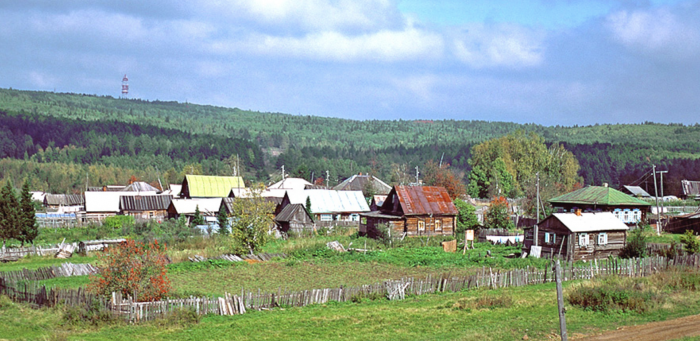
Eslanda doesn’t have any photos of her village, but this image gives an idea of it
.
“Of men there was just one veteran amputee and one mentally disabled young man, who lived with his mom, a war widow, and was pitied and loved by all. He was the village shepherd, taking everyones cows and goats to wild fields and meadow to graze, returning them at sunset, a happy daily event, bells ringing, cows mooing, smiling women at their open gates welcoming their obedient ” buryonka”, dochka”, “milka” – all “kormilitsas”( “browny”, ” little daughter”, ” lovely” – all ” providers, feeders).
.
“In summer months they all housed kids, their grandkids from the city, sent by their working parents to be babysat , for fresh air and natural food. These children were also helpers and mushroom hunters in vast natural forests and groves for miles around. This is where they became experts in the edible and poisonous kind of mushrooms. I pity my fellow Americans not ever experiencing or even suspecting the number of different edible mushrooms. The artificially grown white champignons and even rubbery brown “baby bella” are a just the poorest in taste of all the mushrooms I know.
.
“Getting poisoned by mushrooms ( one – “pale poganka”*) was especially dangerous and real. Ambitious and overly self-assured hunters might get in serious trouble, and die and cause others death. Russians “professional ” mushroom hunters are mostly such children, grown close to nature, mushroom hunting every year, all their life.
.
* [I’m pretty sure this is
amanita phalloides, possibly also a term used for amanita virosa – MW]
.

“pale poganka” – Death Cap, amanita phalloides .
.
“Mushroom hunting is a pleasure, and a challenge (hunting is not just a word, though mushrooms don’t run). A talented, knowledgable, observant hunter will get twice as many, and more valuable ones, than a novice, even if he thinks he’s studied and learnt everything mushrooms! Its so exciting, best activity of all, better than fishing and hunting! (first being static, sedentary, with the same view around; second – plain wrong, unnecessary cruelty, killing).
.
“Its never late to start – but learn as much as possible, and, when hunting and finding – remember the warnings and rules – and be sure to have a caring knowledgable and experienced local to go through your basket contents – one mushroom at a time. Then – the other expert – that local’s mother or wife will cook’em, having gotten sure in a process of cleaning and sorting – of their safety.
.
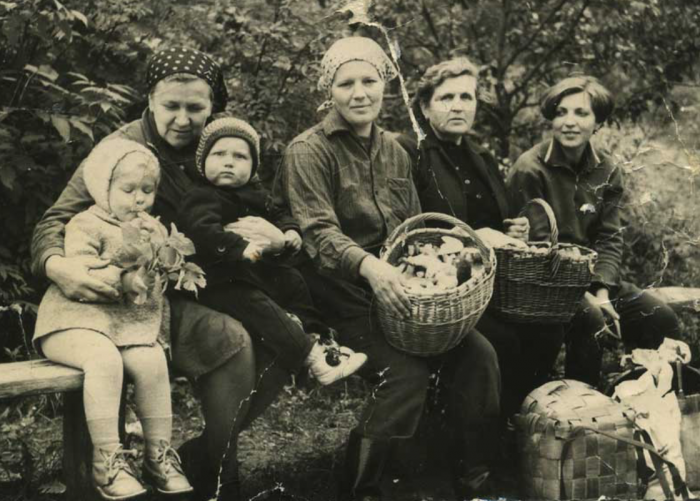
Russian mushroom pickers. Photo credit: Olga Boyarskaya
.
“And after that enjoy, and learn, whIch ‘breeds’ of mushrooms are good for what – not all for every dish. Some only for pickling – there are two ways of pickling, only one with vinegar among other ingredients. Some for soups, others for sauteeimg with onions, with or without adding sourcream. And the best, spongy under umbrella, especially one sort – ” “beliy” or “borovik” – the king of all mushrooms!* – is good to dry, in a great old-fashioned rural “Russian petch”/Russian stove”, or in the regular oven on low with the door open, not cooking, just drying.
.
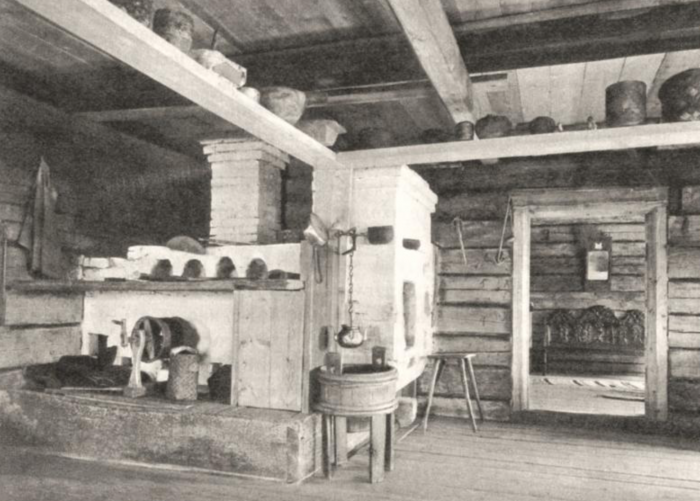
Traditional Russian stove – “Petch” – great for drying mushrooms
.
“Wild mushrooms can be used to prepare soups – no meat or chicken just mushroom broth! It takes time and skills, and the result…! All champignon growers would become bankrupt if people had known, experienced the many tastes of those mushrooms. But, as the Russian proverb goes ” In case of no fish – crowfish is fish!”
.
“I know all about mushrooms, I not only learned it naturally, I mastered while growing, maturing and even getting old. I know how to tell the edible one from its poisonous twin, and not by taste, god forbid! A description of recognizing is helpful, but not enough. It must be during continuous, every-season experience from oh-so-observant childhood to total maturity, combined hunting, cleaning, examining, smelling, taking into consideration the knowledge of habitual location, type of trees growing there, and many many other not even describable factors! Its an art. Thats why it’s so fascinating, the treasure of Russian cultural experience.
.
“I forget the name of the author, a Russian journalist and writer, who wrote a book titled “Грибная охота”, ‘Мushroom Hunting’. The fascinating details about mushroom hunting are intertwined with the history of his native place deep in Russia, its people, their beliefs and life as it is. Fascinating read to those who “have a clue”, definitely wont have found audience in the clueless US.
.
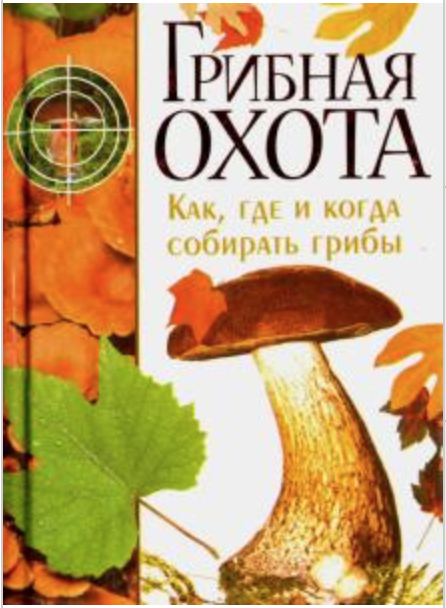
Eslanda’s favourite mushroom book – not available in English translation, as far as I can tell (MW)
.
“Two kinds of berry bushes were grown by many – gooseberry of many kinds, with berries of fifferent size, shape, color and level of sweetness, and red- and black- currant. They are winter resistant, dont require any care, fruit reliably. Redcurrant is the best for naturally prepared jelly, having thickening properties in itself.
.
“Blackcurrant – “chOrnaya smorOdinah” – is the most precious provider of Vitamin C, valued by all Russians, Germans – all Slavic and other Europeans, especially those in the Nothern countries. Even now, when in season, city dwellers buy freshly harvested blackcurrants to make jams, jellies and other potent preserves. Blackcurrants have some distinct taste and aroma, very different from other berries we know. Blackcurrant leaves add a pleasant taste and aroma to tea. Fresh blackcurrant berries are never eaten raw, by the way, but redcurrants are, mostly by kids.
.
“But – and I return to “hunting” – the surrounding woods had, on the sunny ridges and medows and deep inside – abundant variety of berries for willing pickers. Wild ruspberries, blackberries, blueberries, huckleberrirs, mulberries, chokeberries, bird cherries, ashberries/rowanberries, “kostianika”/rubus saxatilis (there’s no English word, only the Latin term). And on swampy ateas – cranberries, cloudberries, cowberries, and “morOshkah” (again, no English word found). And small forest strawberries – way more delicious and aromatic than the strawberries we know, especially if grown industrially.
.
“Many of the berries have not only culinary, or food supply value, but medicinal properties to them, known for generations. In some areas of Russia harvesting of these wild fruit is also a source of a supplemental income, delivered to the ” пункт приема грибов, ягод и целебных трав” – a reception point for mushrooms, berries and medicinal herbs.
.
“In Russian pharmacies, as well in the chain of cooperative product stores ( some of them names are ” Gifts of nature” ) one can see boxes with dried Echinacea, Bird cherry, mixed wildberry or herbal teas, flaxseed, dried mint, oak bark, wild rose hips… . Just like semiliterate country women in the past – smart and educated city women used the bounties of edible wild fruit of forests, marches and wild fields to tease the taste buds, but mostly for prevention or treating many ilnesses and conditions the natural, gentle way, with no side effects.
.
“Some berries are not for eating, but to make preserves. Not only sugary – cowberries, tiny hard low acidity berries – are preserved in a brine (sugar, salt and (maybe) some leaves or herbs). Some – wild rosehips, blueberries, raspberries can be dried.
.
“My memory, my tastebuds still remember, feel the taste of all those gifts of nature. Sometimes, when my mom was still living, I went to peasant markets (farmers markets) to bring home some precious memory of taste, seemed forgotten or not even recognised anymore by many Russian city dwellers. To reminisce, cry with happy tears, about my unique, poor and oh-so-rich Russian childhood.
.
“I can talk about the topic forever, including Russian cuisine, so tasty and various compared to mostly bland American food. I literally mean – cuisine, the elaborately prepared dishes, appetisers, not steaks or file mignons. Those do not require discriminating tastebuds, timing of adding different ingredients, knowledge of how to make the most with the least, the incredibly tasty soups, meat dishes, many incredible, mouthwatering appetizers and salads.
.
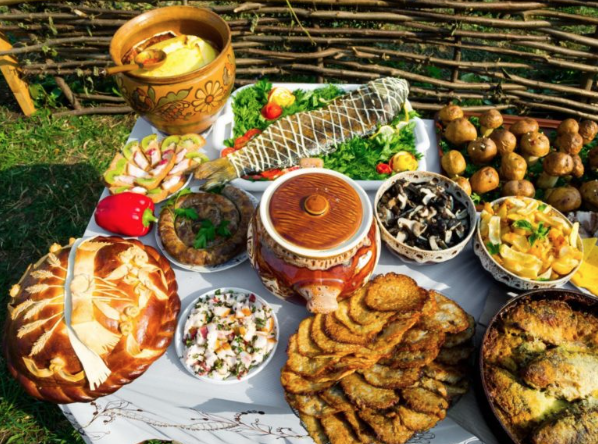
Some traditional Russian dishes
.
“The topic of how Americans visiting Soviet Russia, with its scarcity of food products in store, no bounty of packaged food – all those cans/bottles/containers/ shakers/ colourful big and little boxes – were pleasantly shocked when invited to a dinner with Russians, in their homes or in restaurants: they couldn’t believe their eyes and tastebuds. I could entertain you forever.
.
“All I write is from my own experience. I graduated from a famous Peoples’ Friendship University, then taught there for many years. Long summer leaves, to allow myself some vacation on a Black or Baltic sea resort – working with foreign scholars and students of Russian (including American Study abroad programs), as a facilitator at big events – Olympic games, International Youth Festival, Milllennium of Russian Christianity…
.
” I also worked in other countries – Lithuanian State University, lived there for 3 years, Lublin ( Polish) University ( summer school),one ac.year in Cambodia, after the end of “killing fields”. Worked at two Universities somultaneously, with international efforts to restore life and the ruined system of higher education.
.
“You asked for pictures – you’re not in luck. People didnt have cameras then, those who had were not, in poor devastated depopulated Russian villages. Photo camera was not affordable or easily found in Russia on those years. and photo products’ quality (film, paper) left plenty to be desired, as they say.
.
“In later life I enjoyed delightful mushroom hunting minutes from the peaceful resort town of Druskininkai in Lithuania. My friend, a Lithuanian grandmother of 70, has an apartment in this town and a lovely modern “dacha” – summerhouse. The village of town residents’ dachas is lovely, safe, with beautiful gardens and little ponds, blooms and blooming vines… She might be willing to have some nice American mushroom hunter as a guest, for a modest fee.
.
“I hope to make a special trip to Russia next year, if the pandemic situation clears up, and mushroom hunting is on my list!
.
“I came to live and work in her father’s country in 1990, before the collapse of the Soviet Union, and lived in Pennsylvania, Delaware and now Maryland.”
I asked Eslanda for a recipe and she sent me the information below. In today’s world of over-detailed recipes, I love that she has given “the sense” of the soup, rather than precise detail.
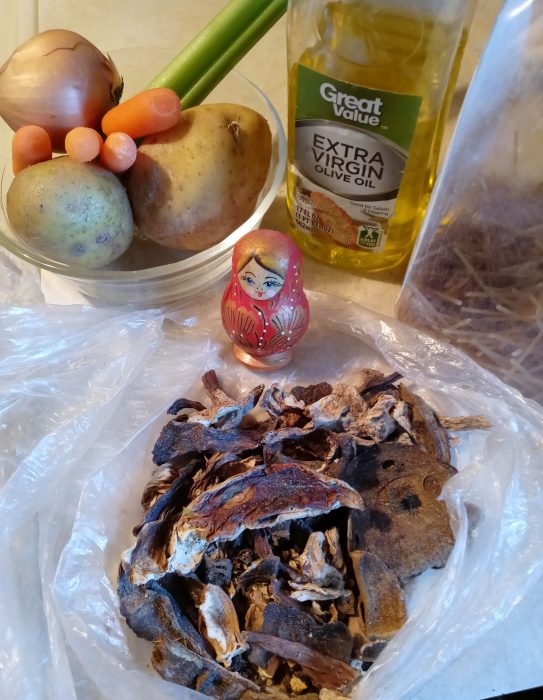
Some of Eslanda’s ingredients for Russian mushroom soup
“I made an arrangement in the photo (above) of dried mushrooms and main ingredients – veggies (no tomatoes or fresh sweet peppers, celery is also not necessary, i’ve got used to put it in almost every soup already while living here, in the US. Better – no celery). And pasta, better – noodles, but I just break in less than 1 inch pieces any pasta available. Never rice or beans/peas ( legumes) in mushroom soup!
.
“But if not an experienced (American, lol!) person tries to make this soup just dumping all together – believe me, it’d be an awful failure. Thats why Russian dishes, especially soups made by a fine restaurant chef or an elaborate cook – a woman of a household – are so delicious – the secret is in how and when.
.
“My ex husband, a Mexican, former educator, now the owner of a big gourmet restaurant – couldnt part with me, until I wrote down the preparation of all his favourite Russian recipes, and was “standing by” with speakerphone while he actually was cooking each one in his home. Because messing up with what to add when, what wrong mode of heat, and what herbs when and other details – will never get the cook to the expected result.
.
“Of course, bayleaf, right herbs – no basil or oregano! No garlic. And no meat or chicken in this classic Russian soup of dried mushrooms.
.
“The amount of dried mushrooms in the photo will be enough for a good half gallon pot of delicious soup.
And an important feature – where on earth i got those mushrooms? From a “bAbushka” ( be sure not to repeat American phonetic handycap when incorporating Russian words into English. Not ” babUshka”!)
I got them in… 2006, 14 years ago, I brought a whole canvas sack of them. This is the last of my stash, stored in a fridge out of reach of moth and other dry goods critters. They might have lost some of their aroma, but I still get that a great soup out of them.
.
Dry mushrooms ( again, its not written for those who thinks that i mean those mushrooms from the store, its not even about all forest mushrooms, even if they are spongy type [ MW – I’m pretty sure Eslanda is talking about dried boletus edulis –
full details and how to dry them here]).
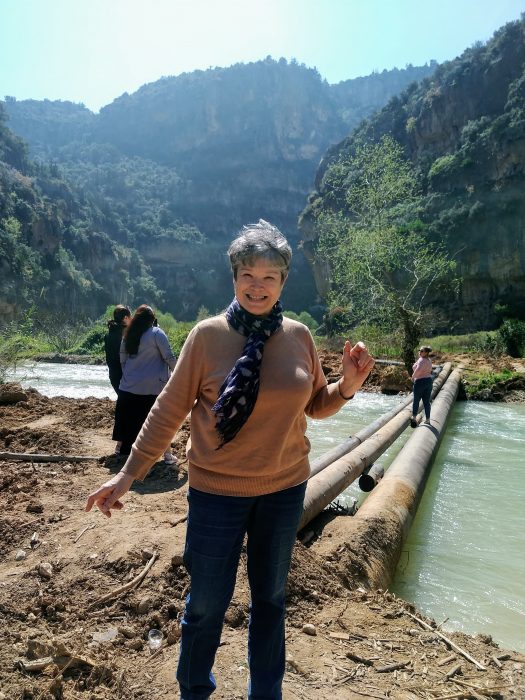
Eslanda: “Picture of myself in Turkey, where i spent 6 months away from the pandemic in the US, March- September. The picture there was taken 3 days before the announcement of mandatory self-isolation. The virus seemed as something almost not real, faraway in China – came to our lives. And nothing seems the same anymore”.
I hope you found Eslanda’s reminiscences and insights as interesting, insightful and entertaining as I do.
If you have any comments or questions for Eslanda, please add them below and Eslanda will be able to see them and can reply to you here.
.
I am interested in sharing more perspectives from different foraging cultures on my blog. If you have a story, experience, reminiscence or recipe that has an interesting cultural perspective on foraging/wild food that you are willing to share, please drop me an email – mark@gallowaywildfoods.com .
















1 Comment
As a Russian born in the 70s in the Soviet Union I can confirm all that Eslanda has written and I’ve experienced a lot of it even then – the birch sap being sold in shops in large 3 l jars. Even though I grew up in Moscow and didn’t have grandparents in a village to spend summers with (they lived in Central Asia where I went every year for three months to enjoy the vast variety of fresh fruit and veg, and of course, summer heat) we still went mushroom hunting every autumn and one day trip would usually supply us with mushrooms to last the rest of the year. Growing up, making preserves of seasonal fruit and veg was very much part of our family’s life. We didn’t grow our produce living in an apartment and not owning a dacha but we always went to farmers’ markets to buy an array of tasty food (grown or foraged by others) to eat and to preserve. Wild garlic was the first spring salad of the year, first proper greens to see you out of a cold and long winter and it still holds a special place in my heart even though I’ve never picked it myself until I came to Ireland. Herbs are still very popular, not in salads, but teas for their health benefits and different dried herbs are sold in ordinary pharmacies (and still prescribed by doctors alongside other meds). Ivan chai (rosebay willowherb) is now sold in shops, its popularity soaring in recent years. And of course, people love wild berries, paying a premium for them. Loved reading this. Thanks for sharing.
P.S. I re-read what I wrote and seem to have confirmed Eslanda’s statment that the Russians love long sentences:))))